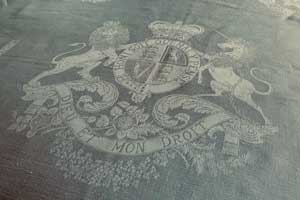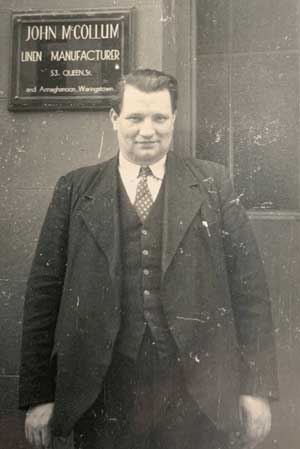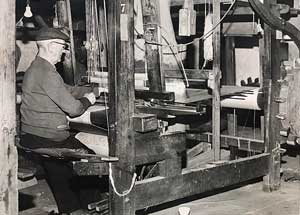Emperor, Queen and Cardinal: a forgotten chapter in the story of Irish linen
Published in Features, Issue 5 (September/October 2022), Volume 30By Deborah White

Above: The British royal coat of arms, one of several pieces produced by McCollums to mark the accession of Queen Elizabeth II in 1952.
It was an anxious wait for Mr Duigenan, Keeper of Irish Antiquities at the National Museum of Ireland. After protracted negotiation the star artefact of his upcoming ‘Special Folklore Exhibition’ was making its way to Dublin from Lurgan, Co. Armagh, strapped to the bed of a twenty-horsepower lorry. Prior arrangement with the Surveyor of Customs and Excise at Dundalk would ensure duty-free entry for the old wooden damask handloom. It had been thought prudent to avoid travelling by rail, German bombs having fallen north and south of the border the previous year. Accompanying the loom was John Leathem, a fifth-generation handloom linen damask weaver. For over a hundred years the loom had stood in his family home in Rampart Street, Lurgan, where he recalled taking to it as a schoolboy, anxious to emulate his older brothers. It was one of four that had belonged to his father, Joshua. Now, father and son were to ready the loom for a display of damask napkin weaving at the exhibition’s scheduled to open on 18 July 1942. Those planning to attend were as curious to see the two men, as they were the loom.
Ghosts of Ireland’s industrial past
The Leathems belonged to a world few imagined persisted. Centuries old, it nested along the south Down and north Armagh border. From the early eighteenth century, the craft had passed down through the tight-knit community. Rarely was it gifted to outsiders. Against all the odds and every prediction, it had survived into the twentieth century, a heresy to the gospel of economic progress. It had seen off the steam loom, which had tried and failed to match it for fineness, quality and ‘soft handle’, and endured the seismic economic dislocations of the First World War. Now, hoary with old age and bloodied by the Great Depression of 1929 and the ensuing austerity of the 1930s, it was coming to its end. Of the remaining handloom factories, Walkers of Banbridge (under the umbrella of Robinson and Cleaver) retained a single handloom, its weaver acting as a gateman in the mornings. Ireland Bros. Ltd., where the Leathems worked, was fast phasing out its handloom factory in Queen Street, Lurgan. The sweep of historical forces had left behind a new landscape. The days of Irish handwoven linen damask gracing the tables of the Maharajahs of India and the crowned heads of Europe was a fading memory. Linen was now a vital wartime commodity, ‘Blitz Cloth’, used for protecting doors and windows against bomb blast, its requisite product. In the north, there was little inclination to mourn the ancient craft’s passing. The destruction of its industrial heartland in May 1941 had left little time for nostalgia.

Above: John McCollum in 1948 outside his newly opened Queen Street handloom factory. He was only forty-five when he died in January 1962. (Private collection)
Jack McCollum
The monotonous chant of the loom, which had rung out from every weaver’s cottage was fast falling silent; looms standing idle, or more often fed to the fire. Pleading, cajoling and coaxing his neighbours to give him their redundant looms, a remarkable fifteen-year-old, Jack McCollum, determined to save them. Beginning in 1931, when he was apprenticed to Ireland Bros., he managed to accumulate a grand total of 49 by the time of the folklore exhibition’s opening eleven years later. His experiences there tempered his respect for the craft and the singular human capital of the region. In protest at its downsizing of the handloom department, he resigned in 1942. Taking a position in Lurgan Technical College as an instructor of weaving he endeavoured to enthuse a new generation to persevere with the craft, an uphill struggle given its bleak prospects. Nonetheless, with the end of the Second World War in sight, on 15 April 1945, he boldly rented a disused handloom factory in Annaghanoon, Waringstown. He shoehorned 27 of his looms into the dilapidated building and rented-out a further 22 to weavers (three of them female) in their cottages. The Leathems were amongst the first he employed; the handloom factory of Ireland Bros. having closed the previous year. The sight of the factory being re-fitted brought tears to many of the weavers’ eyes, but to observers of the trade it seemed an act of folly, a step backwards at a time when the industry was in desperate need of modernization.
Stepping promptly into the place left by his old employer, he contracted with its suppliers, bleachers, and finishers. Northern Ireland’s recently revised New Industries Development Act, designed to broaden the base of the country’s staple industries by attracting new investment, ironically provided him with his first break. In a twist that the architects of the scheme could scarce have foreseen, he became eligible for grant aid by virtue of giving employment to male workers. Meantime, in the US, damask’s traditional market, peace had sparked unprecedented economic growth, and with it a seemingly insatiable demand for linen. A single order for the passenger ship, the Southern Cross, overfilled William Liddel’s huge warehouse; the surplus having to be stored in neighbouring bleach greens. Laying aside any plans it may have had for modernization, the industry rushed headlong to make hay while the sun shone. McCollum, it seemed, could not have timed his revival any better. His close friend, Fred Monroe, mayor of Lurgan and damask designer, decided to throw his weight behind the efforts to give back employment to the town’s handloom weavers, and opened his own handloom damask factory in the town in 1946. With sales soaring, McCollum expanded his business in 1948, establishing a sister factory in Queen Street, Lurgan, next door, poignantly, to the now abandoned Ireland Bros. factory.

Above: John Leathem, a fifth-generation handloom linen damask weaver, amongst the first employed by John McCollum in 1945. (PRONI)
Royal patronage
Transatlantic consumption accounted for some 80% of McCollum’s orders; sterling’s devaluation in 1950 helping sales. The home market, long the Achilles heel of the damask trade, was disappointingly unresponsive. Keen to explore its potential he sent one of his most trusted weavers, Robert Foye, to the Royal Norfolk Show, held on King George VI’s Amner estate in 1950. Whilst giving a demonstration of weaving Foye caught the attention of the Queen, who came over to chat. They were to meet again the following year, at the Ulster Farm and Factory Exhibition, Northern Ireland’s Festival of Britain satellite show. Later, in recognition of fifty-years of service to weaving, Foye was awarded a British Empire Medal. The royal link was cemented when, on the sudden death of George VI in February 1952, an order for handwoven damask was placed to mark the accession of his daughter, Elizabeth II. Using a design drawn up in Waringstown for the coronation of King Edward VII in 1902, McCollum inserted the Queen’s Royal cyphers in each of the corners and removed the defunct Star of India. Delighted with the high quality of the cloths, annual orders from the royal household for Buckingham Palace, Sandringham and Windsor Castle followed. A golden thread, royal patronage was to weave a new chapter for Ulster’s handloom industry.
1952 also marked a dramatic plummet in consumer demand for linen, the post-war boom ending as suddenly as it had begun. Over the coming five years the net output of linen fell by £7.5 million. Ulster’s linen industry had to re-invent itself, embracing new artificial fibres such as viscose rayon. Easier to care for and cheaper to produce, they reflected a changing lifestyle that had begun in the 1920s. By 1954, having neglected to modernize, the industry belatedly scrambled to rationalize. Many found themselves saddled with obsolete plant and falling profits and attempted to diversify in the hope of higher returns. All the while, McCollum’s continued on its path of expansion, the golden thread having lost none of its sheen. Order books began to read like the pages from Debretts. In 1954, Cardinal Spellman, archbishop of New York and the face and voice of the Catholic Church in America, placed an order for several banqueting tablecloths. Three years later, the firm was weaving eight eleven-metre-long damask banqueting cloths and matching napkins for Emperor Hailie Selassie of Ethiopia. Woven with his cypher, tiered crown and Lion of Judah motifs, they were a fitting stage for the gold plates, Christofle cut glassware and hundred-plus courses that were a feature of dining in his imperial court.
Untimely death of McCollum
In January 1962, as his weavers busied themselves with a fresh order for Buckingham Palace, McCollum, without warning, died of heart failure. He was forty-five. The firm’s prosperity and the craft’s revival had been driven by his singular commitment, resolve and eternal optimism. He had invested every ounce of his energies, time and capital in the success of the venture. The difficult decision having been made to put the firm to bed, the weavers prayed for a buyer. Their hopes quickly waned as the depression in the linen industry deepened. On the brink of closure, in 1963, William Ewart & Son, Ltd., bought over the firm, retaining McCollum’s name. For the world’s largest vertical linen company, it was a radical departure, and was met with skepticism by the ministry of commerce who suspected the company was more interested in financial grants than the long-term future of hand-weaving. With immediate effect, Ewarts streamlined the firm, and closed the Lurgan factories. Only the Annaghanoon factory remained. For the first few years they focused on building up stock and engaged their New York branch house to develop a strategy for sales in the US. Events, however, outpaced them, as the company struggled to weather the near terminal decline of the linen industry. The sale in 1964 of its sprawling Crumlin Road plant in Belfast signaled its intent to disengage itself from linen. By late 1967, the clatter of the looms and the banter of the men had fallen silent in Annaghanoon. Looms stood dismantled and propped against the walls. John Leathem was one of five remaining weavers. Known as the ‘Queen’s Weavers’, they were a select band of men who had been entrusted by McCollum to weave the most prestigious orders. As a new year dawned, they set to work on an order for twelve dozen napkins for Windsor Castle. It was to be the last commercial handloom linen damask ever woven in Ireland; the firm closed its doors in late January 1968. What little press attention it received was hastily jostled from the front pages by the rapidly unfolding ‘Troubles’.
Deborah White is a master hand-loom linen damask weaver and an Arts and Humanities Research Council-Northern Bridge Consortium doctoral researcher at Ulster University.
Further reading
W.H. Crawford, The handloom weavers and the Ulster linen industry (Belfast, 1972)
C. Gill, The rise of the Irish linen industry (Oxford, 1925).
K. James, Handloom weavers in Ulster’s linen industry, 1815-1914 (Dublin, 2007).
















